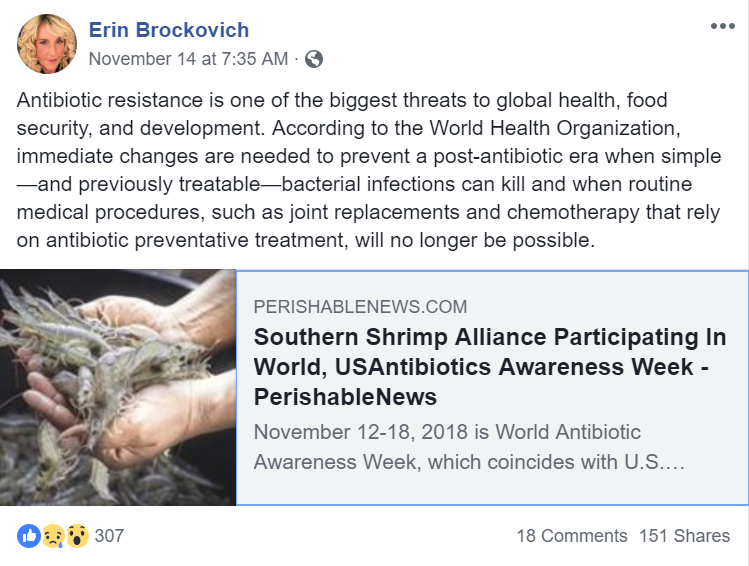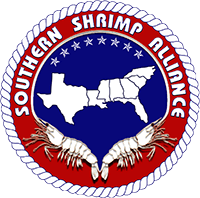The Southern Shrimp Alliance reached more than a million unique individuals with messages about the use of antibiotics in aquaculture as part of World Antibiotic Awareness Week (Nov 12-18), a global campaign that coincides with U.S. Antibiotics Awareness Week to raise awareness of the importance of appropriate antibiotic use to combat the threat of antibiotic resistance. SSA observed the week through news alerts, media outreach, frequent social media posts, and participation in a “Global Twitter Storm.”
“It was important for shrimpers to participate in Antibiotics Awareness Week because the seafood industry can and must take actions to stop drug resistance. The FDA has not approved any antibiotic for use in shrimp aquaculture. Any unauthorized use of antibiotics in shrimp farming, whether detected or not, can lead to antibiotic resistant bacteria,” said John Williams, executive director of the Southern Shrimp Alliance.
All of the top antibiotics used in aquaculture are included on the World Health Organization’s list of critically/highly important antibiotics for human health and the number of publications linking drug-resistant bacteria to seafood has increased by 800% over the past three decades.[1]
Antimicrobial resistance from environmental pollution is among the biggest emerging health threats according to the United Nations Environment Programme (UNEP), which found that up to 75% of antibiotics in aquaculture can be lost into the surrounding environment, leading to antimicrobial resistance.[2]
In a 2017 peer-reviewed study, scientists deemed aquaculture systems and farms to be “hotspots for AMR genes,” where significant genetic exchange and recombination can occur to shape the evolution of future resistance profiles. They went on to demonstrate that such mutations are already occurring and that the effects will last longer than the practices.[3]

Image from Facebook of Erin Brockovich, the environmental activist and consumer advocate that inspired a movie, sharing the Southern Shrimp Alliance’s news alert as published by PerishableNews.com
Testing Insufficient
Canada, EU, Switzerland, Australia, Japan, & Korea have acted—often more so than the US—to eliminate antibiotic-tainted shrimp from their food supply. This makes the US the largest, most open market for shrimp contaminated with banned antibiotics.
The FDA tests for a limited number of antimicrobial agents including antibiotics, antivirals, antifungals, and biocides in seafood. Less than .1% of seafood is actually tested, yet every month—many times from the same bad actors—FDA finds residues of antibiotics prohibited in food production.
Additionally, shrimp farmers may switch to critically/highly important antibiotics not tested by FDA, as found by the European Commission. As a result of an April 2018 audit on Indian aquaculture, the European Commission recommended expanding testing to four types of antibiotics. These classes of antibiotics have important therapeutic applications that are endangered by development of antimicrobial resistant bacteria. The actions in Europe suggest FDA’s list is incomplete.
Action is Needed Now
Foreign shrimp farmers use antimicrobals for non-therapeutic purposes—to promote growth, weight gain, disease prevention—and inappropriately, such as to treat EMS and other viruses. Much of the world’s farmed shrimp supply is raised in developing countries by poor farmers with little economic security. Medicated feed, some of which include banned antibiotics, are sold to peasant farmers to help safeguard their crop.
The FDA depends on the action of foreign processors and U.S. importers to help ensure the safety of imported seafood from unsafe drug residues.[4]
“Shrimp processors, exporters, importers and food distributors that look the other way on antibiotics for a cheaper product shows a complete disregard for laws designed to keep consumers and society safe,” stated Williams. “Not every shrimp producer is part of the problem, but we all can be part of the solution. Change can’t wait.”
Bacteria are becoming resistant to antibiotics faster than scientists are developing new ones, leading us to a world where currently treatable infections may kill more than cancer by 2050.
Footnotes:
[1] Hansa Y. Done and Rolf U. Halden. “Reconnaissance of 47 Antibiotics and Associated Microbial Risks in Seafood Sold in the United States,” J Hazard Mater. 2015 Jan 23; 0: 10–17. Published online 2014 Oct 5. doi: [10.1016/j.jhazmat.2014.08.075]. Found at https://www.ncbi.nlm.nih.gov/pmc/articles/PMC4254636/?fbclid=IwAR20bbyJPsn0FHmDe_83HkiE-1oJNILx7hyB8tIewwdMWtBkGQ3v6Qk-z1M
[2] United Nations Environment Programme (2017). Frontiers 2017: Emerging Issues of Environmental Concern, December 2017 found at https://www.unenvironment.org/resources/frontiers-2017-emerging-issues-environmental-concern
[3] Joy E. M. Watts, Harold J. Schreier, Lauma Lanska, and Michelle S. Hale. Mar. “The Rising Tide of Antimicrobial Resistance in Aquaculture: Sources, Sinks and Solutions” Special Issue Advances and New Perspectives in Marine Biotechnology II 2016. Mar. Drugs 2017, 15(6), 158; https://doi.org/10.3390/md15060158
[4] U.S. Government Accountability Office. “IMPORTED SEAFOOD SAFETY: FDA and USDA Could Strengthen Efforts to Prevent Unsafe Drug Residues,” GAO-17-443: Published: Sep 15, 2017. Publicly Released: Oct 2, 2017.
